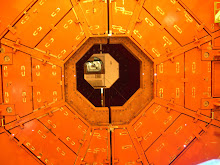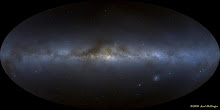 The British ATLAS Team inspecting their Stargate Portal, the higher-dimensional ‘shipping container’ ready for activation, beating the American LOST Team by 2.2 years. The Russians were the first to crack the top secret potential of the LHC Time Machine, but forgot to commercialize it.
The British ATLAS Team inspecting their Stargate Portal, the higher-dimensional ‘shipping container’ ready for activation, beating the American LOST Team by 2.2 years. The Russians were the first to crack the top secret potential of the LHC Time Machine, but forgot to commercialize it.Now the American LOST Team has the Hollywood edge, with millions watching every week, and an Internet frenzy that eclipses anything on real science. Fifty million hits on one LOST fan site alone. The LHC Money Train smokes, while mighty NASA bites the Martian dust.
It gets goofier with the new Dan Brown movie, Angels and Demons, and Tom Hanks, scheduled for launch May 15, 2009. Stealing antimatter from CERN to make a bomb to blow up the Vatican. CERN did produce antiprotons with the old LEP and even a tiny bit of antihydrogen, enough to blow up a jumbo cup of movie popcorn, though they’re not planning to produce any with the LHC, unless by accident, in which case it might blow up and uh-oh fuse some helium.
So the interest in the LHC is big, sideways. Considering its real world unknown potential to blow itself up with a super bosenova, and maybe Geneva, or produce a runaway black hole that might devour the planet, or strangelets, or magnetic monopoles or wormholes, there’s, oddly, little enough real interest outside the physics community.
The problem is, that apart from a few critics with scientific credentials who have gone public, those with some international clout, either support the LHC, like Stephen Hawking, or are working directly or are collaborating with CERN, about 8,000 or half of all particle physicists. The others are teaching or working at other labs. Some have their doubts about the wisdom of going ahead with the LHC, but they’re either obliged to keep them private to protect their jobs and reputations, or they voice their concerns during coffee breaks at committee meetings. For those physicists outside the CERN loop, CERN invites them to contact Michelangelo Mangano, a CERN physicist and quantum spin doctor, who handles serious objections at the LHC. He must be good. Complaints go in and like in a black hole, they never come out again.
With the mainstream media unwilling to investigate possible dangers at the LHC, that leaves the field open for anonymous and amateur scientists to criticize the LHC, about a dozen major websites and blogs geared to monitor the LHC, and comments posted on hundreds of news sites that run articles on the LHC, even on social bookmarking sites and anonymous blogs and blogs within blogs. Comments run from the abysmally dumb, to panic-stricken, to rumor-mongering, to honest complaining or just having fun with doomsday, though there is some erudite analysis, tantalizing but not easily verifiable. Here are a few worth reading.
From Physicsworld: vbarashkov June 24, 2008 2:58 PM
I doubt that is how a black hole can be formed, considering that as we know so far it takes an entire star to form one. Not only that, but for a black hole to form exactly how much must the two atoms be compressed. Certainly a lot more than they can be in a head on collision even at near twice the speed of light. If I had 20 ton iron sphere, and I compressed it to fit on a tip of a needle, the only thing it would do is explode with enough energy to destroy the entire planet. . .
Anyone seen a black 20 ton iron sphere? It was here a second ago? Never mind, Val found the vodka.
From Geekology: VtFarmboy - February 12, 2008 11:22 AM
I think Mr. Scott needs to get back to the enterprise. He's needed the Klingons are attacking and the warp drive dilithum crystals are decaying.
And Spock. Is that new compression algorithm ready? We need to beam up the LHC before it blows up. Professor Rössler wants it on the Moon right now.
From The Great Beyond, BlogsNature: Walt 06-18-08 01:00 AM
. . .The CERN-LHC website Mainpage itself states quote: "There are many theories as to what will result from these collisions..." This stunning admission is because they truly don't know what's going to happen. They are experimenting with forces they don't understand to obtain results they can't comprehend. If you think like most people do that 'They must know what they're doing.' you could not be more wrong. The second part of the quote reads "...but what's for sure is that a brave new world of physics will emerge from the new accelerator..." A molecularly changed or Black Hole consumed Lifeless World? The end of the quote reads "as knowledge in particle physics goes on to describe the workings of the Universe." These experiments to date have so far produced infinitely more questions than answers but there isn't a particle experimentalist physicist alive who wouldn't gladly trade his life to glimpse the "God particle", and sacrifice the rest of us with him. . .
Walt has it right. Here is the actual embarrassing CERN webpage, Our understanding of the Universe is about to change...
From NatureNews: David Wenbert 06 May 2008
. . . 4. Perhaps the unqualified legacy of monumental failure and waste exhibited by the high energy and plasma physics community is instructive here. After more than 50 years of building ever larger and more powerful colliders and plasma reactors, at a cost of untold Billions of dollars, NO useful scientific breakthroughs have ever been recorded from either such device, and both a Fundamental Understanding of Matter, and Controlled Fusion Energy remain totally elusive. The abject failure of particle physicists to have achieved their objectives (i.e. discovering the Higgs Boson) with prior collider experiments - although widely predicted to have done so - indicates the low reliability of their certainty in the outcome of these experiments. Consistently wrong, over decades, in their assertions that 'the last big machine' would illuminate the structure of matter - or ignite a controlled breakeven reaction, for that matter - leaves us with no alternative but to conclude that the same physicists may be no more accurate in predicting the behavior of 'the next big machine. The math doesnt fix this, since each such project had 'good math' to contend it would meet its scientific objectives, and yet, repeatedly, failure ensued. The rich, deep, and unbroken record of failure in these "Big Physics" projects is a Red Flag that the warnings from the fringe on potential distasters should be heeded. The physicists who propound the reliability of their assumptions have yet to be proven right once, whereas, the alarmists only need to be right 'once'. The Precautiionary Principle would seem wisely applied in these collider debates.
Read the thread and Wenbert’s full comment, in response to a previous comment by Richard Dawson who wrote to CERN and got some answers he quotes from the CERN letter.
One important point on micro black holes, received no comments, but is worth another look. The unnamed CERN source wrote, “But since, in case they (mBH) really exist, there will be millions produced, this means that indeed a few of them would be stopped within earth and start accretion. This however does not mean that they will crush the earth.” This is the point most commentators have been worried about. The odd thing is that at first CERN ignored the possibility of black hole formation, then embraced it publically as the LHC Black Hole Factory, while in their latest safety report, the LSAG is busy swatting mBH as though they were CERN’s famous TeV mosquitoes. That embarrassing Safety at the LHC webpage has been deleted, replaced with a summary of the new LSAG report where Einstein has been resurrected, and therefore “. . . it is impossible for microscopic black holes to be produced at the LHC.” Mosquitoes however, linger on Are LHC Collisions Safe?
The best analysis ever was made inadvertently, by The New York Times, when they called the LHC, The Large Hardon Collider, which fits in well with Big Bang Theory, on everybody’s mind since the hit TV show.
Seriously, there is one dissenting group of physicists at CERN, forced to do retro cabaret or else get lepton, none other than those sexy control room bottoms from the biggest collider ever, Les Horribles Cernettes.
It gets goofier with the new Dan Brown movie, Angels and Demons, and Tom Hanks, scheduled for launch May 15, 2009. Stealing antimatter from CERN to make a bomb to blow up the Vatican. CERN did produce antiprotons with the old LEP and even a tiny bit of antihydrogen, enough to blow up a jumbo cup of movie popcorn, though they’re not planning to produce any with the LHC, unless by accident, in which case it might blow up and uh-oh fuse some helium.
So the interest in the LHC is big, sideways. Considering its real world unknown potential to blow itself up with a super bosenova, and maybe Geneva, or produce a runaway black hole that might devour the planet, or strangelets, or magnetic monopoles or wormholes, there’s, oddly, little enough real interest outside the physics community.
The problem is, that apart from a few critics with scientific credentials who have gone public, those with some international clout, either support the LHC, like Stephen Hawking, or are working directly or are collaborating with CERN, about 8,000 or half of all particle physicists. The others are teaching or working at other labs. Some have their doubts about the wisdom of going ahead with the LHC, but they’re either obliged to keep them private to protect their jobs and reputations, or they voice their concerns during coffee breaks at committee meetings. For those physicists outside the CERN loop, CERN invites them to contact Michelangelo Mangano, a CERN physicist and quantum spin doctor, who handles serious objections at the LHC. He must be good. Complaints go in and like in a black hole, they never come out again.
With the mainstream media unwilling to investigate possible dangers at the LHC, that leaves the field open for anonymous and amateur scientists to criticize the LHC, about a dozen major websites and blogs geared to monitor the LHC, and comments posted on hundreds of news sites that run articles on the LHC, even on social bookmarking sites and anonymous blogs and blogs within blogs. Comments run from the abysmally dumb, to panic-stricken, to rumor-mongering, to honest complaining or just having fun with doomsday, though there is some erudite analysis, tantalizing but not easily verifiable. Here are a few worth reading.
From Physicsworld: vbarashkov June 24, 2008 2:58 PM
I doubt that is how a black hole can be formed, considering that as we know so far it takes an entire star to form one. Not only that, but for a black hole to form exactly how much must the two atoms be compressed. Certainly a lot more than they can be in a head on collision even at near twice the speed of light. If I had 20 ton iron sphere, and I compressed it to fit on a tip of a needle, the only thing it would do is explode with enough energy to destroy the entire planet. . .
Anyone seen a black 20 ton iron sphere? It was here a second ago? Never mind, Val found the vodka.
From Geekology: VtFarmboy - February 12, 2008 11:22 AM
I think Mr. Scott needs to get back to the enterprise. He's needed the Klingons are attacking and the warp drive dilithum crystals are decaying.
And Spock. Is that new compression algorithm ready? We need to beam up the LHC before it blows up. Professor Rössler wants it on the Moon right now.
From The Great Beyond, BlogsNature: Walt 06-18-08 01:00 AM
. . .The CERN-LHC website Mainpage itself states quote: "There are many theories as to what will result from these collisions..." This stunning admission is because they truly don't know what's going to happen. They are experimenting with forces they don't understand to obtain results they can't comprehend. If you think like most people do that 'They must know what they're doing.' you could not be more wrong. The second part of the quote reads "...but what's for sure is that a brave new world of physics will emerge from the new accelerator..." A molecularly changed or Black Hole consumed Lifeless World? The end of the quote reads "as knowledge in particle physics goes on to describe the workings of the Universe." These experiments to date have so far produced infinitely more questions than answers but there isn't a particle experimentalist physicist alive who wouldn't gladly trade his life to glimpse the "God particle", and sacrifice the rest of us with him. . .
Walt has it right. Here is the actual embarrassing CERN webpage, Our understanding of the Universe is about to change...
From NatureNews: David Wenbert 06 May 2008
. . . 4. Perhaps the unqualified legacy of monumental failure and waste exhibited by the high energy and plasma physics community is instructive here. After more than 50 years of building ever larger and more powerful colliders and plasma reactors, at a cost of untold Billions of dollars, NO useful scientific breakthroughs have ever been recorded from either such device, and both a Fundamental Understanding of Matter, and Controlled Fusion Energy remain totally elusive. The abject failure of particle physicists to have achieved their objectives (i.e. discovering the Higgs Boson) with prior collider experiments - although widely predicted to have done so - indicates the low reliability of their certainty in the outcome of these experiments. Consistently wrong, over decades, in their assertions that 'the last big machine' would illuminate the structure of matter - or ignite a controlled breakeven reaction, for that matter - leaves us with no alternative but to conclude that the same physicists may be no more accurate in predicting the behavior of 'the next big machine. The math doesnt fix this, since each such project had 'good math' to contend it would meet its scientific objectives, and yet, repeatedly, failure ensued. The rich, deep, and unbroken record of failure in these "Big Physics" projects is a Red Flag that the warnings from the fringe on potential distasters should be heeded. The physicists who propound the reliability of their assumptions have yet to be proven right once, whereas, the alarmists only need to be right 'once'. The Precautiionary Principle would seem wisely applied in these collider debates.
Read the thread and Wenbert’s full comment, in response to a previous comment by Richard Dawson who wrote to CERN and got some answers he quotes from the CERN letter.
One important point on micro black holes, received no comments, but is worth another look. The unnamed CERN source wrote, “But since, in case they (mBH) really exist, there will be millions produced, this means that indeed a few of them would be stopped within earth and start accretion. This however does not mean that they will crush the earth.” This is the point most commentators have been worried about. The odd thing is that at first CERN ignored the possibility of black hole formation, then embraced it publically as the LHC Black Hole Factory, while in their latest safety report, the LSAG is busy swatting mBH as though they were CERN’s famous TeV mosquitoes. That embarrassing Safety at the LHC webpage has been deleted, replaced with a summary of the new LSAG report where Einstein has been resurrected, and therefore “. . . it is impossible for microscopic black holes to be produced at the LHC.” Mosquitoes however, linger on Are LHC Collisions Safe?
The best analysis ever was made inadvertently, by The New York Times, when they called the LHC, The Large Hardon Collider, which fits in well with Big Bang Theory, on everybody’s mind since the hit TV show.

 A bosenova explosion of rubidium-85, from a new burstmovie by NIST, 2008
A bosenova explosion of rubidium-85, from a new burstmovie by NIST, 2008 Cointrin
Cointrin
























